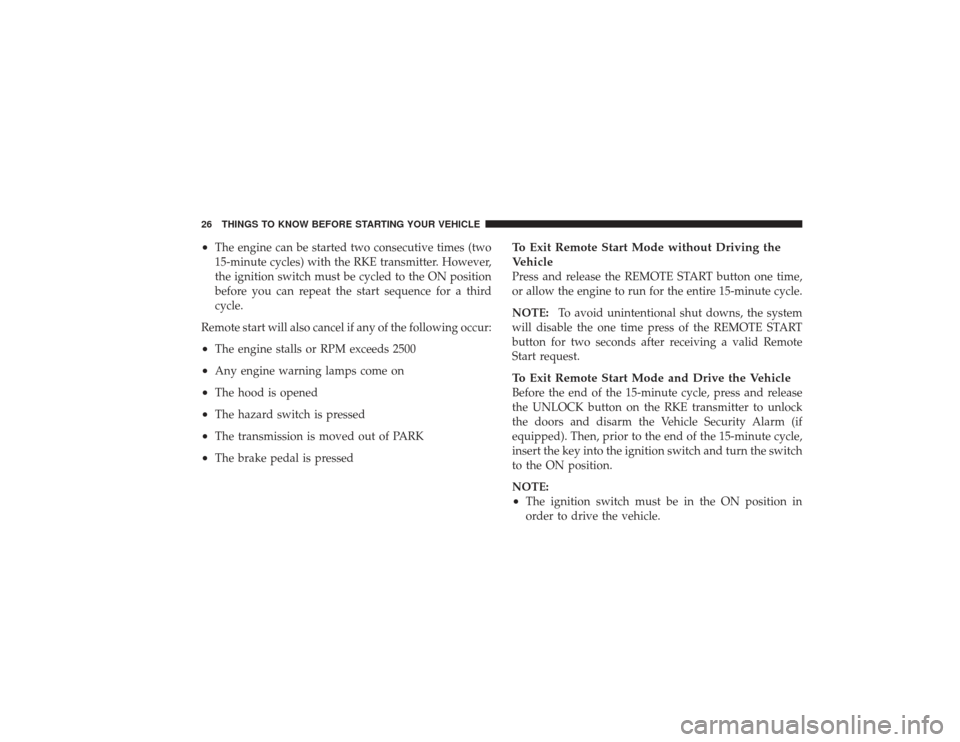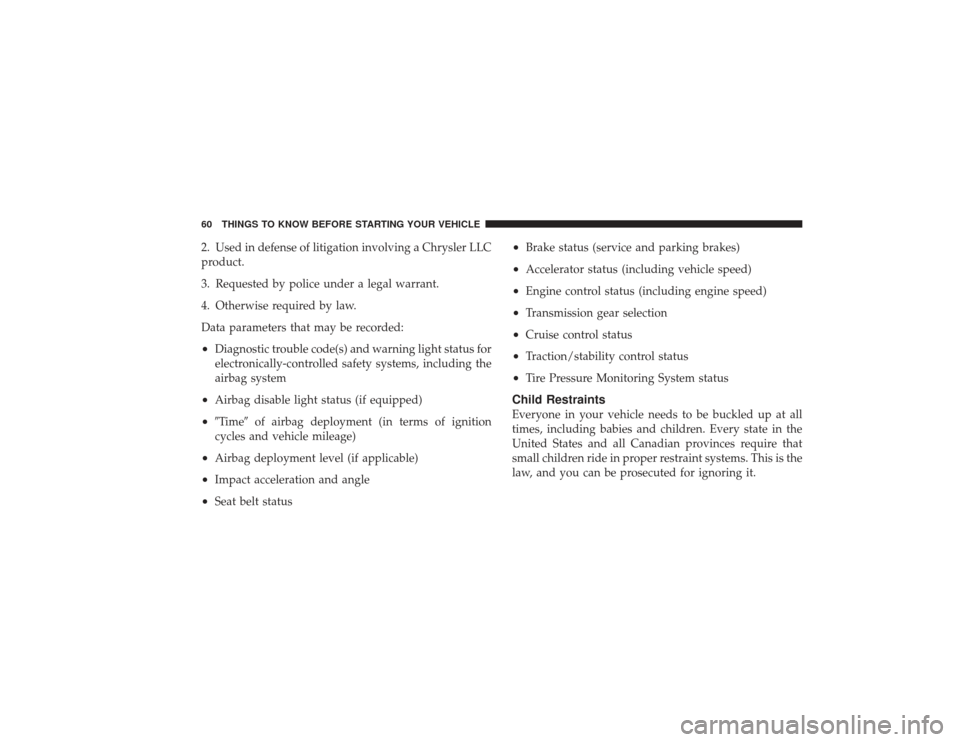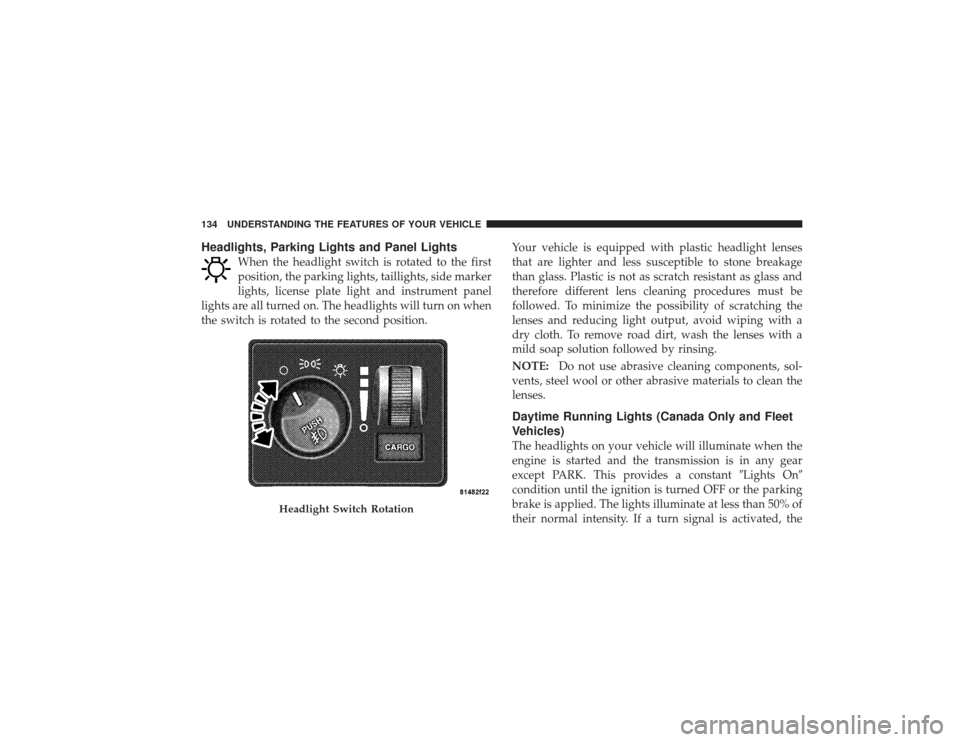Page 11 of 532
THINGS TO KNOW BEFORE STARTING YOUR VEHICLECONTENTS�A Word About Your Keys ................ 12
▫ Ignition Key Removal ................. 12
▫ Locking Doors With A Key ............. 14
� Steering Wheel Lock — If Equipped ........ 14
▫ To Manually Lock The Steering Wheel ..... 14
▫ To Release The Steering Wheel Lock ....... 14
▫ Automatic Transmission Ignition Interlock
System ............................. 14 �
Sentry Key� ......................... 15
▫ Replacement Keys ................... 16
▫ Customer Key Programming ............ 17
▫ General Information .................. 18
� Vehicle Security Alarm — If Equipped ....... 18
▫ Rearming Of The System .............. 18
▫ To Set The Alarm .................... 18
▫ To Disarm The System ................ 19
� Illuminated Entry System — If Equipped ..... 20
2
Page 14 of 532
A WORD ABOUT YOUR KEYSThe authorized dealer that sold you your vehicle has the
key code numbers for your vehicle locks. These numbers
can be used to order duplicate keys from your authorized
dealer. Ask your authorized dealer for these numbers
and keep them in a safe place.
Ignition Key Removal
Automatic TransmissionPlace the shift lever in PARK. Turn the ignition switch to
the LOCK position, and remove the key.
Ignition Key
Ignition Switch Positions
1 — ACC (ACCESSORY) 4 — ON/RUN
2 — LOCK 5 — START
3 — OFF
12 THINGS TO KNOW BEFORE STARTING YOUR VEHICLE
Page 16 of 532

Locking Doors With A KeyYou can insert the key with either side up. To lock the
door, turn the key rearward. To unlock the door, turn the
key forward. For door lock lubrication, see “Body Lubri-
cation” in Section 7 of this manual.STEERING WHEEL LOCK — IF EQUIPPEDYour vehicle may be equipped with a passive steering
wheel lock. This lock prevents steering the vehicle with-
out the ignition key. If the steering wheel is moved
approximately a half turn in either direction and the key
is not in the ignition switch, the steering wheel will lock.To Manually Lock the Steering WheelWith the engine running, turn the steering wheel upside
down, turn off the engine and remove the key. Turn the
steering wheel slightly in either direction until the lock
engages.
To Release the Steering Wheel LockInsert the key in the ignition switch and start the engine.
If the key is difficult to turn, move the wheel slightly to
the right or left to disengage the lock.
NOTE:If you turned the wheel to the right to engage
the lock, you must turn the wheel slightly to the right to
disengage it. If you turned the wheel to the left to engage
the lock, turn the wheel slightly to the left to disengage it.Automatic Transmission Ignition Interlock SystemThis system prevents the key from being removed unless
the shift lever is in PARK. It also prevents shifting out of
PARK unless the key is in the ON positions, and the
brake pedal is depressed.
14 THINGS TO KNOW BEFORE STARTING YOUR VEHICLE
Page 27 of 532

REMOTE STARTING SYSTEM — IF EQUIPPED
This system uses the Remote Keyless Entry
(RKE) transmitter to start the engine conve-
niently from outside the vehicle while still
maintaining security. The system has a targeted
range of 328 ft (100 m).
NOTE: The vehicle must be equipped with an auto-
matic transmission to be equipped with Remote Start.
How to Use Remote StartAll of the following conditions must be met before the
engine will remote start:•
Shift lever in PARK
•
Doors closed
•
Hood closed
•
Hazard switch off
•
Brake switch inactive (brake pedal not pressed)
•
Ignition key removed from ignition switch
•
Battery at an acceptable charge level
•
RKE PANIC button not pressed
To Enter Remote Start
Press and release the REMOTE START button
on the RKE transmitter twice, within five sec-
onds. The parking lights will flash and the horn
will chirp twice (if programmed). Then, the
engine will start and the vehicle will remain in the
Remote Start mode for a 15-minute cycle.
NOTE:
•
The park lamps will turn on and remain on during
Remote Start mode.
•
For security, power window and power sunroof op-
eration (if equipped) are disabled when the vehicle is
in the Remote Start mode.THINGS TO KNOW BEFORE STARTING YOUR VEHICLE 25
2
Page 28 of 532

•
The engine can be started two consecutive times (two
15-minute cycles) with the RKE transmitter. However,
the ignition switch must be cycled to the ON position
before you can repeat the start sequence for a third
cycle.
Remote start will also cancel if any of the following occur:
•
The engine stalls or RPM exceeds 2500
•
Any engine warning lamps come on
•
The hood is opened
•
The hazard switch is pressed
•
The transmission is moved out of PARK
•
The brake pedal is pressed
To Exit Remote Start Mode without Driving the
VehiclePress and release the REMOTE START button one time,
or allow the engine to run for the entire 15-minute cycle.
NOTE: To avoid unintentional shut downs, the system
will disable the one time press of the REMOTE START
button for two seconds after receiving a valid Remote
Start request.To Exit Remote Start Mode and Drive the VehicleBefore the end of the 15-minute cycle, press and release
the UNLOCK button on the RKE transmitter to unlock
the doors and disarm the Vehicle Security Alarm (if
equipped). Then, prior to the end of the 15-minute cycle,
insert the key into the ignition switch and turn the switch
to the ON position.
NOTE:•
The ignition switch must be in the ON position in
order to drive the vehicle.
26 THINGS TO KNOW BEFORE STARTING YOUR VEHICLE
Page 62 of 532

2. Used in defense of litigation involving a Chrysler LLC
product.
3. Requested by police under a legal warrant.
4. Otherwise required by law.
Data parameters that may be recorded:•
Diagnostic trouble code(s) and warning light status for
electronically-controlled safety systems, including the
airbag system
•
Airbag disable light status (if equipped)
•
�Time�of airbag deployment (in terms of ignition
cycles and vehicle mileage)
•
Airbag deployment level (if applicable)
•
Impact acceleration and angle
•
Seat belt status
•
Brake status (service and parking brakes)
•
Accelerator status (including vehicle speed)
•
Engine control status (including engine speed)
•
Transmission gear selection
•
Cruise control status
•
Traction/stability control status
•
Tire Pressure Monitoring System status
Child RestraintsEveryone in your vehicle needs to be buckled up at all
times, including babies and children. Every state in the
United States and all Canadian provinces require that
small children ride in proper restraint systems. This is the
law, and you can be prosecuted for ignoring it.
60 THINGS TO KNOW BEFORE STARTING YOUR VEHICLE
Page 83 of 532

▫Front Instrument Panel Cupholders
(40–20–40 Seats) — Automatic
Transmission ....................... 165
▫ Front Instrument Panel Cupholders
(Bucket Seats) ....................... 166
▫ Rear Cupholder (Quad Cab�)—
If Equipped ........................ 167
� Storage ............................. 167
▫Center Storage Compartment (40–20–40 Seat) –
If Equipped
........................ 167
▫ Center Storage Compartment (Bucket Seats) –
If Equipped ........................ 169
▫ Storage And Seats (Quad Cab� Models).... 171
▫ Plastic Grocery Bag Retainers —
If Equipped ........................ 172 �
Rear Window Features .................. 172
▫ Rear Window Defroster And Heated Outside
Mirrors — If Equipped ................ 172
▫ Power Sliding Rear Window —
If Equipped ........................ 173
▫ Sliding Rear Window — If Equipped ...... 174
� Fold Flat Load Floor — If Equipped ........ 174
� Pickup Box .......................... 176
� Slide-In Campers ...................... 178
▫ Camper Applications .................. 178
� Easy-Off Tailgate ...................... 178
UNDERSTANDING THE FEATURES OF YOUR VEHICLE 81
3
Page 136 of 532

Headlights, Parking Lights and Panel Lights
When the headlight switch is rotated to the first
position, the parking lights, taillights, side marker
lights, license plate light and instrument panel
lights are all turned on. The headlights will turn on when
the switch is rotated to the second position. Your vehicle is equipped with plastic headlight lenses
that are lighter and less susceptible to stone breakage
than glass. Plastic is not as scratch resistant as glass and
therefore different lens cleaning procedures must be
followed. To minimize the possibility of scratching the
lenses and reducing light output, avoid wiping with a
dry cloth. To remove road dirt, wash the lenses with a
mild soap solution followed by rinsing.
NOTE:
Do not use abrasive cleaning components, sol-
vents, steel wool or other abrasive materials to clean the
lenses.
Daytime Running Lights (Canada Only and Fleet
Vehicles)The headlights on your vehicle will illuminate when the
engine is started and the transmission is in any gear
except PARK. This provides a constant �Lights On�
condition until the ignition is turned OFF or the parking
brake is applied. The lights illuminate at less than 50% of
their normal intensity. If a turn signal is activated, the
Headlight Switch Rotation
134 UNDERSTANDING THE FEATURES OF YOUR VEHICLE